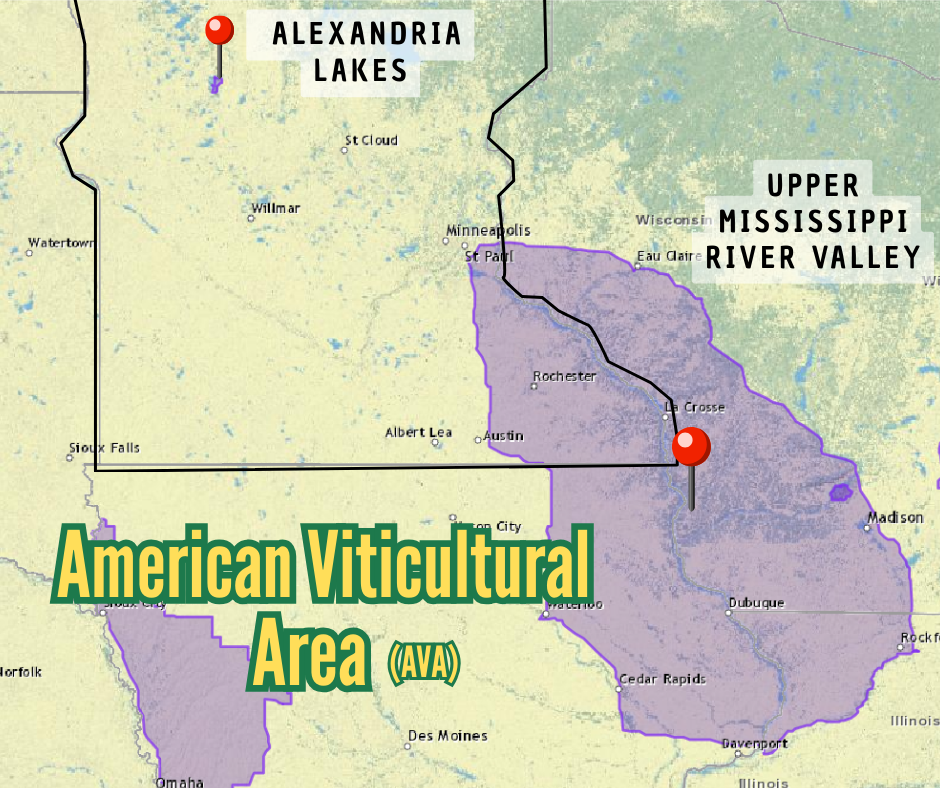
🏷️ What is a Denomination of Origin and How Does it Vary Across Wine-Producing Countries?
When it comes to wine, a denomination of origin (DO) is much more than just a label. It’s a guarantee of authenticity, a marketing asset, and a protector of regional identity. But how these systems work differs greatly depending on the country.
Let’s explore how the concept of DO is applied in the United States, Europe, Chile, and Argentina.
🇺🇸 United States: AVAs (American Viticultural Areas)
In the U.S., officially recognized wine regions are called AVAs (American Viticultural Areas). These are designated by the Alcohol and Tobacco Tax and Trade Bureau (TTB) and are used to define areas with distinctive geographic features—such as climate, soil, or elevation.
- ❌ AVAs do not regulate winemaking techniques or grape varieties.
- ✅ To use an AVA on a label, at least 85% of the grapes must come from that area.
- 🌟 Famous examples: Napa Valley, Willamette Valley.
Minnesota in Focus
- Upper Mississippi River Valley: The largest AVA in the U.S., covering parts of Minnesota, Iowa, Wisconsin, and Illinois. Known for its cold climate and hybrid varieties like Frontenac and Marquette.
- Alexandria Lakes: A small, Minnesota-exclusive AVA established in 2005. Nestled between glacial lakes and rolling farmland, it’s home to pioneering wineries like Carlos Creek Winery.
🇫🇷 Europe: A Tradition of Strict Regulation
Europe is known for its strict and historic wine laws. Here, a DO also means controlled practices and a deep respect for tradition.
Key Systems:
- France: AOC (Appellation d'Origine Contrôlée)
- Italy: DOC / DOCG (Denominazione di Origine Controllata/Garantita)
- Spain: DO / DOCa (Denominación de Origen/Calificada)
These systems often:
- Define permitted grape varieties
- Set rules for farming, vinification, and aging
- Rely heavily on the idea of terroir
🌍 Examples include Bordeaux AOC (France), Barolo DOCG (Italy), and Rioja DOCa (Spain).
🇨🇱 Chile: Valleys and Regional Identity
Chile’s wine DO system is overseen by the Servicio Agrícola y Ganadero (SAG) and is organized by zones, regions, and subregions.
- 📍 Regions include Maipo Valley, Colchagua, Casablanca, and Limarí.
- 🗺️ These DOs are more geographic than technical but still follow basic rules.
- 🍇 At least 75% of the grapes must originate from the declared region (many producers aim for 85%).
🇦🇷 Argentina: IG and Emerging DOCs
Argentina employs a dual system:
- IG (Indicación Geográfica) – A geographic designation with no strict rules on grape or vinification methods.
- DOC (Denominación de Origen Controlada) – A more regulated system controlling varieties, yields, and aging.
Notable mentions:
- 🏅 Luján de Cuyo – Argentina’s first DOC, focused on Malbec.
- 🏞️ San Rafael – Another DOC in Mendoza.
- 🌄 Other well-known IGs: Uco Valley, Cafayate (Salta), Patagonia.
📊 Quick Comparison Table
| Country | System | Regulates Quality? | Terroir-Based? | Examples |
|---|---|---|---|---|
| USA | AVA | ❌ No | ✅ Yes | Napa, Willamette, Alexandria Lakes |
| France | AOC | ✅ Yes | ✅ Yes | Bordeaux, Champagne |
| Italy | DOC/DOCG | ✅ Yes | ✅ Yes | Chianti, Barolo |
| Spain | DO/DOCa | ✅ Yes | ✅ Yes | Rioja, Priorat |
| Chile | DO | ⚠️ Partially | ✅ Yes | Maipo, Colchagua |
| Argentina | IG / DOC | DOC: ✅ / IG: ❌ | ✅ Yes | Luján de Cuyo, Salta |
🧾 Final Thoughts: Why Does Denomination of Origin Matter?
Denominations of origin protect the identity of wine regions and give consumers an idea of what to expect from a bottle. Whether you're drinking a tightly regulated Barolo or a flexible AVA wine from the U.S., the common goal is the same: to celebrate and safeguard the unique character of a place.
❓ How Important Is a Denomination of Origin?
It depends—on the consumer, the producer, and the market.
But generally speaking, DOs are powerful tools for ensuring:
- 🏞️ Connection to place
- ✅ Trust in quality
- 📜 Respect for tradition
